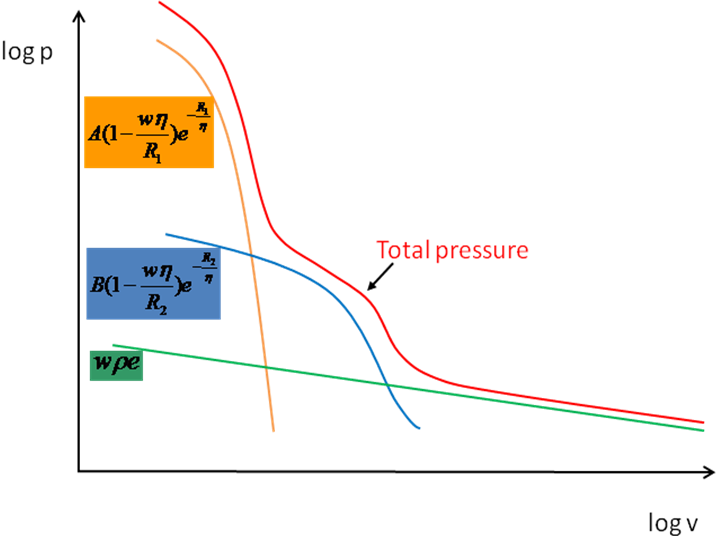The JWL equation of state describes the detonation product expansion down to a pressure of 1 kbar for high energy explosive materials and has been proposed by Jones, Wilkins and Lee according to the following equation
, where ρ0 is the reference density, ρ the density and η = ρ/ρ0.
The values of the constants A, B, R1, R2 and ω for many common explosives have been determined from dynamic experiments.
The detonation process can be initiated in one of two ways: burn on time or burn on compression. To use the burn on time method, a detonation point must be added to the analysis. For further information, see Detonation Point. This is the recommended method for detonation initiation. The second method, burn on compression, is described below, however, its use is not recommended:
Burn on Compression
In this process, the detonation wave is not predefined but the unburned explosive is initially treated similarly to any other inert material. However, as an initiating shock travels through the unburned explosive and traverses elements within the explosive the compression of all explosive elements is monitored. If and when the compression in a cell reaches a predefined value, the chemical energy is allowed to be released at a controlled rate.
Burn on compression may be defined in one of two ways:
Pre-burn bulk modulus KBK is zero. The elements start to release their energy when the element compression μ exceeds a specified fraction of the Chapman-Jouguet compression:
μ > BCJμCJ, where μCJ = PCJ/(ρDCJ 2)
Pre-burn bulk modulus KBK is non zero. The elements start to release their energy when the element pressure exceeds a specified fraction of the Chapman-Jouguet pressure:
P = KBK(ρ/ρ0–1) > BCJPCJ
The critical threshold compression and the release rate are parameters that must be chosen with care in order to obtain realistic results. The burn on compression option may give unrealistic results for unconfined regions of explosive since the material is free to expand at the time of initial shock arrival and may not achieve sufficient compression to initiate energy release in a realistic time scale.
Typically, a burn logic based upon compression is more successful in Lagrangian computations rather than Eulerian.
Additional Energy Deposition
The standard JWL equation of state can be used in combination with an energy release extension whereby additional energy is deposited over a user-defined time interval. Thermobaric explosives show this behavior and produce more explosive energy than conventional high energy explosives through combustion of inclusions, like aluminum, with atmospheric oxygen after detonation.
This option is activated when the additional specific energy is specified different from zero.
Note: The constants A, B, R1, R2 and ω should be considered as a set of interdependent parameters and one constant cannot be changed unilaterally without considering the effect of this change on the other parameters.
This equation of state can only be applied to solid bodies.
The Poisson's ratio is assumed to be zero when calculating effective strain.
Table 11.15: Input Data
| Name | Symbol | Units | Notes |
|---|---|---|---|
| Parameter A | A | Stress | |
| Parameter B | B | Stress | |
| Parameter R1 | R1 | None | |
| Parameter R2 | R2 | None | |
| Parameter ω | ω | None | |
| C-J Detonation Velocity | DCJ | Velocity | |
| C-J Energy/unit mass | Energy/mass | ||
| C-J Pressure | PCJ | Stress | Burn on compression logic |
| Burn on compression fraction | BCJ | None | Burn on compression logic |
| Pre-burn bulk modulus | KBK | Stress | Burn on compression logic |
| Adiabatic constant | None | ||
| Additional specific internal energy/unit mass | Energy/mass | Additional energy release | |
| Begin Time | Time | Start time of additional energy release | |
| End Time | Time | End time of additional energy release |
This equation of state can only be used with solid elements.
Custom results variables available for this model:
| Name | Description | Solids | Shells | Beams |
|---|---|---|---|---|
| PRESSURE | Pressure | Yes | No | No |
| DENSITY | Density | Yes | No | No |
| COMPRESSION | Compression | Yes | No | No |
| INT_ENERGY | Internal Energy | Yes | No | No |
| TEMPERATURE | Temperature | Yes | No | No |
| BURN_FRAC | Burn Fraction | Yes | No | No |



